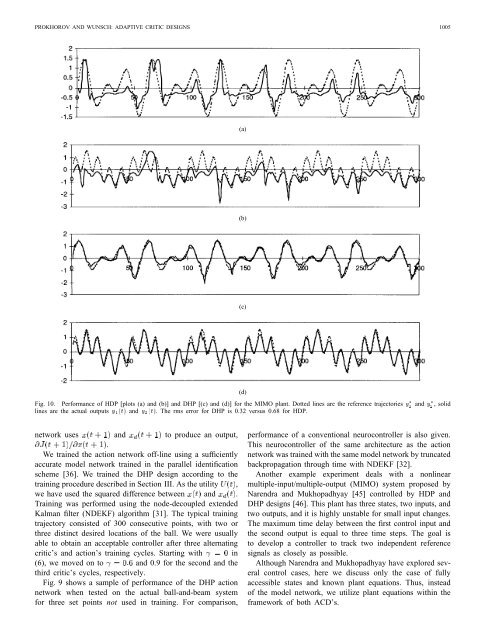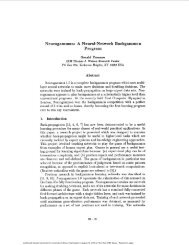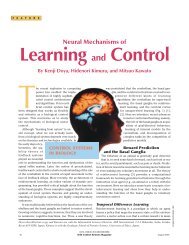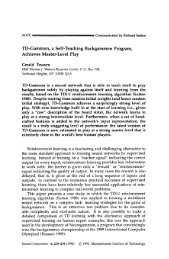1004 <strong>IEEE</strong> TRANSACTIONS ON NEURAL NETWORKS, VOL. 8, NO. 5, SEPTEMBER 1997(a)(b)Fig. 9. Test results of two neurocontrollers for the ball-and-beam system. Edges of the beam correspond to 61, and its center is at zero. Dotted lines are thedesired ball positions x d (set points), solid lines are the actual ball trajectory x(t). (a) Conventional neurocontroller trained by the truncated backpropagationthrough time with NDEKF; (b) DHP action network tested on the same set points as in (a).other researchers in the field, the reader is referred to [33]and [43].The first problem deals with a simplified model of a commercialaircraft which is to be landed in a specified touchdownregion of a runway within given ranges of speed and pitchangle [22]. The aircraft is subject to wind disturbances thathave two components: wind shear (deterministic) and turbulentwind gusts (stochastic). To land safely, an external controllershould be developed to provide an appropriate sequence ofcommand elevator angles to the aircraft’s pitch autopilot.Along with actual states of the plane, a controller may alsouse desired values of the altitude and the vertical speedsupplied by an instrument landing system (ILS).To trade off between closely following the desired landingprofile from the ILS when far from the ground, and meetingthe landing constraints at the touchdown, one could use thefollowing utility function:(23)where , , are experimentally determined constants,and , , and are the actual altitude,vertical speed, and horizontal position of the plane. To avoida singularity at , we treat both terms as fixedto unity whenever ft.We found the problem with its original system of constraintsnot challenging enough since even the nonadaptivePID controller provided in [22] could solve it very well. Wecomplicated the problem by shortening the touchdown regionof the runway by 30%.We have compared the PID controller, ADHDP, HDP, andDHP for the same complicated version of the autolanderproblem. Implementation details are discussed in [28] and[30], and results are summarized in Fig. 8. The most importantconclusion is that in going from the simplest ACD, ADHDP,to the more advanced ACD’s one can attain a significantimprovement in performance.We have also applied DHP to control of actual hardware,a ball-and-beam system [44]. 4 The goal is to balance theball at an arbitrary specified location on the beam. We usethe recurrent multilayer perceptron for both model and actionnetworks. The model network inputs the current position of theball, , and the servo motor control signal, the latter beingthe only output of the action network with a sigmoidal outputnode. It predicts the next ball position, . The actionnetworks inputs from the model network and ,the desired ball position at the next time step. The critic4 Although we initially attempted an HDP design, we failed to make it work:its critic was not accurate enough to allow the action’s training.
PROKHOROV AND WUNSCH: ADAPTIVE CRITIC DESIGNS 1005(a)(b)(c)(d)Fig. 10. Performance of HDP [plots (a) and (b)] and DHP [(c) and (d)] for the MIMO plant. Dotted lines are the reference trajectories y1 3 and y3 2 , solidlines are the actual outputs y1(t) and y2(t). The rms error for DHP is 0.32 versus 0.68 for HDP.network uses and to produce an output,.We trained the action network off-line using a sufficientlyaccurate model network trained in the parallel identificationscheme [36]. We trained the DHP design according to thetraining procedure described in Section III. As the utility ,we have used the squared difference between and .Training was performed using the node-decoupled extendedKalman filter (NDEKF) algorithm [31]. The typical trainingtrajectory consisted of 300 consecutive points, with two orthree distinct desired locations of the ball. We were usuallyable to obtain an acceptable controller after three alternatingcritic’s and action’s training cycles. Starting with in(6), we moved on to and 0.9 for the second and thethird critic’s cycles, respectively.Fig. 9 shows a sample of performance of the DHP actionnetwork when tested on the actual ball-and-beam systemfor three set points not used in training. For comparison,performance of a conventional neurocontroller is also given.This neurocontroller of the same architecture as the actionnetwork was trained with the same model network by truncatedbackpropagation through time with NDEKF [32].Another example experiment deals with a nonlinearmultiple-input/multiple-output (MIMO) system proposed byNarendra and Mukhopadhyay [45] controlled by HDP andDHP designs [46]. This plant has three states, two inputs, andtwo outputs, and it is highly unstable for small input changes.The maximum time delay between the first control input andthe second output is equal to three time steps. The goal isto develop a controller to track two independent referencesignals as closely as possible.Although Narendra and Mukhopadhyay have explored severalcontrol cases, here we discuss only the case of fullyaccessible states and known plant equations. Thus, insteadof the model network, we utilize plant equations within theframework of both ACD’s.









